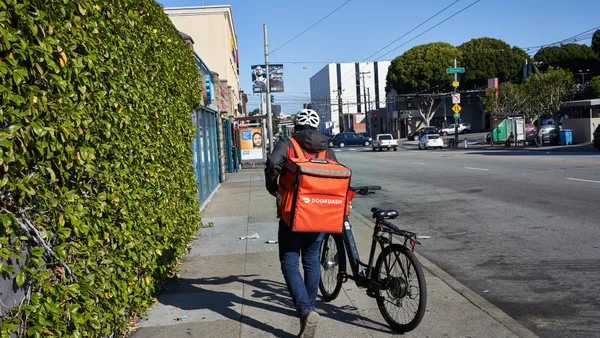Dive Brief:
- Domino’s is actively hiring 20,000 new employees at its U.S. corporate and franchise stores, the company announced in a press release Monday.
- The positions include additional delivery workers, pizza makers, managerial staff and customer service representatives, to respond to the influx in demand for delivery and takeout pizza options. The latest round of hiring comes four months after Domino’s said it would hire over 10,000 employees in its initial response to the novel coronavirus pandemic.
- U.S. supply chain centers for Domino's are also hiring workers to their production and warehouse teams, as well as additional CDL drivers.
Dive Insight:
QSRs, which were already geared toward delivery and carryout before COVID-19 restrictions took hold, continue to reap rewards as the pandemic shows little sign of abating, as evidenced by Domino's latest hiring push. Competitors Pizza Hut and Papa John’s similarly ramped up hiring in March.
U.S. same-store sales for Domino's grew 16.1% for Q2 compared to 3% for the year-ago quarter, which then-CFO Jeff Lawrence attributed to accelerated demand during the novel coronavirus pandemic. The chain also witnessed a net increase of 39 new U.S. locations between late April and mid-July, and a net increase of 45 international stores.
The chain's relatively quick rollout of contactless delivery offerings, as well as a “pizza pedestal” tool that avoids pizzas touching potentially unclean surfaces, have likely helped keep the chain competitive by easing customers' concerns about COVID-19 exposure. CEO Ritch Allison remarked in April that Domino's advertising team had focused on the “important cues” of health and safety to customers, evidenced by its recent 15-second "Peace of Mind" commercial. The company's adapted contactless delivery also involves customers inputting instructions into its website or app on where drivers should place the delivery, who then notify the customer over the phone when its delivered.
The pizza chain's digital ordering infrastructure has also proven to be a significant asset. In April, the company said in its announcement of a new iPad ordering app that around 40% of all U.S. sales are now from online ordering, and at its peak accounted for 80% of all sales.
As chains such as Shake Shack have begun to modify stores toward off-premise and pickup services, Domino’s was able to adapt more quickly without shouldering rent costs of centrally located real estate that come with operating dine-in optimized restaurants.
Domino's in-house delivery service also allowed the chain to avoid third-party delivery fees, which threaten to slow down some restaurants’ recovery efforts and saddle customers with higher prices. Third-party delivery apps have been a vital lifeline for restaurants throughout the pandemic, and municipalities across the U.S. have passed legislation to cap commission fees, but they can come with significant costs to operators. Domino’s meanwhile, has enjoyed a greater degree of control over the delivery-ordering process, translating to fewer operational costs as well as steadier prices for its customers.










